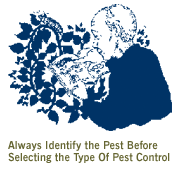 The Maryland Department of Agriculture (MDA), in conjunction with the University of
Maryland Extension (UME) and the Governor's Pesticide Council,
developed a series of brochures to assist individuals to make informed decisions on their pest
control needs. The brochures provide basic information on pest control and pesticide use. There
currently are four brochures available for homeowners. The first brochure "Controlling Pests -
Help for the Consumer" provides background information on pest control and pesticides. The
second brochure "Lawn Care Tips - Help for the Consumer" highlights some of the key issues
associated with pest control and pesticide use for lawn care, with emphasis on the use of
integrated pest management (IPM). The third brochure "Proper Pesticide Use - Help for the
Consumer" addresses the fundamentals of proper pesticide use, and the final brochure "Using IPM
- Help for the Consumer" further addresses the topic of IPM and how it is used in pest
control.
The Maryland Department of Agriculture (MDA), in conjunction with the University of
Maryland Extension (UME) and the Governor's Pesticide Council,
developed a series of brochures to assist individuals to make informed decisions on their pest
control needs. The brochures provide basic information on pest control and pesticide use. There
currently are four brochures available for homeowners. The first brochure "Controlling Pests -
Help for the Consumer" provides background information on pest control and pesticides. The
second brochure "Lawn Care Tips - Help for the Consumer" highlights some of the key issues
associated with pest control and pesticide use for lawn care, with emphasis on the use of
integrated pest management (IPM). The third brochure "Proper Pesticide Use - Help for the
Consumer" addresses the fundamentals of proper pesticide use, and the final brochure "Using IPM
- Help for the Consumer" further addresses the topic of IPM and how it is used in pest
control.
The major goals of the brochures are to help consumers understand:

- What steps to take to control pests.
- What methods of pest control are available, including pest prevention and
non-chemical control.
- How to choose pesticides and how to use, store, and dispose of pesticides
properly.
Plants, insects, rodents, diseases and other organisms are a natural part of the
environment. When they invade an area in which they are not wanted, they are considered to be
"pests". However, there are many times that a perceived pest is actually a beneficial organism and
does not need to be controlled. Termites, fleas, cockroaches, and ants are common insects often
found inside dwellings and are considered pests. Weeds, potato beetles, aphids, and grubs are
some of the pests associated with gardens, lawns and landscape plantings. Some of these pests
can also pose health hazards to you, your family, or pets. As a result, it is very important that you
know and understand the pest problem in order to choose the best pest control option, or options,
that are available to you. Knowing and selecting the proper options for your particular pest
situation is the key to effective, long term pest control. These options include the use of pest
prevention, non-chemical pest control, and/or the use of pesticides. Often times the most effective
pest control strategy is to combine several methods of pest control. This approach is known as
integrated pest management (IPM). One of the best and easiest forms of pest control is to prevent
the situation from actually becoming a pest problem. No matter what pest control option you
choose, it is important to follow these steps:
- Identify the pest problem
- Decide what level of pest control is necessary
- Choose the appropriate pest control option or options
- Evaluate the result to determine its effectiveness.
The brochures are designed to help the homeowner make better informed decisions
regarding pest control and the use of pesticides. They also encourage individuals to seek further
assistance from UME Home and Garden Information Center to effectively control their pest
problems. The Home and Garden Information Center is staffed with experts who can provide
detailed information on lawn, tree, shrub, houseplant, and structural pests and their control. This
information includes: the identification of insects, diseases, weeds, and other pests; available pest
control methods, including pesticides and alternatives; choosing pest resistant plant varieties; and
integrated pest management programs.
| COMMON MEASUREMENTS |
|
1 Gallon (gal.) |
= 128 fluid ounces (fl. oz.)
= 16 cups
= 8 pints
= 4 quarts |
|
1 Quart (qt.) |
= 32 fl. oz.
= 4 cups
= 2 pts. |
|
1 Pint (pt.) |
= 16 fl. oz.
= 2 cups |
|
1 Cup |
= 8 fl. oz. |
|
1 Tablespoon |
= 1/2 fl. oz.
= 3 teaspoons |
|
1 Teaspoon |
= 1/6 fl. oz. |
|
1 fl. oz. |
= 6 teaspoons
= 2 tablespoons |
|
1 Yard (yd.) |
= 3 feet (ft.) |
|
Square Feet (sq. ft.) |
= length (ft.) x width (ft.)
|
|
Nurseries, garden centers and pesticide retail stores are the primary distribution points that
MDA is targeting for distribution of the brochures. If you would like to obtain copies of the
brochures, contact the Maryland Department of Agriculture, Pesticide Regulation Section, 50
Harry S. Truman Parkway, Annapolis, Maryland 21401, or by calling (410) 841-5710.
Remember, if you choose to use a pesticide for your pest control needs, it is important
that you mix and use the proper amount of pesticide as specified on the product label. Always
read and follow label directions. The chart above provides some of the common measurements
that may be needed in the mixing and application of pesticides.
Send E-mail to Robert Hofstetter